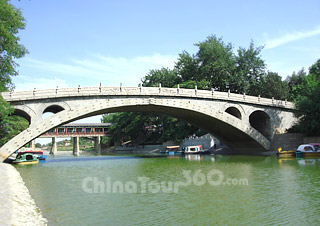 Zhaozhou Bridge of the Sui Dynasty
Zhaozhou Bridge of the Sui Dynasty Chengde Summer Resort
Chengde Summer Resort Jiaoshan Great Wall
Jiaoshan Great Wall Shanhaiguan Mingqing Street
Shanhaiguan Mingqing Street Temple of the Potaraka Doctrine
Temple of the Potaraka Doctrine
With the Bohai Sea to the East, Hebei Province is an important coastal province in North China with a total area of 187,700 square kilometers (72,471 square miles) and a coastline of 487 kilometers (303 miles). The name Hebei means 'north of the Yellow River' and its one-character abbreviation is 'Ji'.
Situated in the central part of the area around Bohai Sea and facing Japan and Korea across the sea, Hebei Province not only serves as a passage connecting Northeast China with other provinces in China, but as an important north outlet to sea for the Northwest provinces. As the only province surrounding Beijing and Tianjin, Hebei maintains long-standing ties with the two metropolises.
Hebei consists of two sections: Hebei Plain (a part of North China Plain) in the east and south, and the mountain ranges along the northern arid western frontiers, presenting an extraordinary landscape painting. The Great Wall of China cuts through northern Hebei from east to west as well, briefly entering the border of Beijing Municipality, and terminates at the seacoast of Shanhaiguan Pass in northeastern Hebei. The highest peak is Mount Xiaowutai in northwestern Hebei, with an altitude of 2,882 meters (9,455 feet).
Hebei Province has a temperate continental monsoonal climate, with dry and windy springs, hot and rainy summers and dry-cold winters. The annual mean temperature is 0 - 14 degrees Celsius (32 - 57.2 degrees Fahrenheit) and the annual precipitation is 300 - 800 millimeters (11.8 - 31.5 inches).
With a history of 5,000 years, Hebei Province has been the political, economic and cultural center of North China for ages. In the past several thousand years, the diligent people have created splendid culture and left rich tourist resources for the later generations. Across the province, there are 304 ancient ruins and groups of ancient buildings including 58 key relics under state protection. The number of historical and cultural relics in the province ranks first in the country along with Shaanxi Province. The total number of natural and human cultural scenic sites ranks second nationally. They include the Chengde Summer Resort, Shanhaiguan Pass at the head of the Great Wall, Beidaihe holiday resort, the Eastern and Western Tombs of the emperors of the Qing Dynasty (1644 - 1911).
With transport facilities, a beautiful environment, a pleasant climate, rich tourist resources and tourist facilities which are improving with each passing day, Hebei has become a bright diamond in tourism, and an ideal tourist place.







